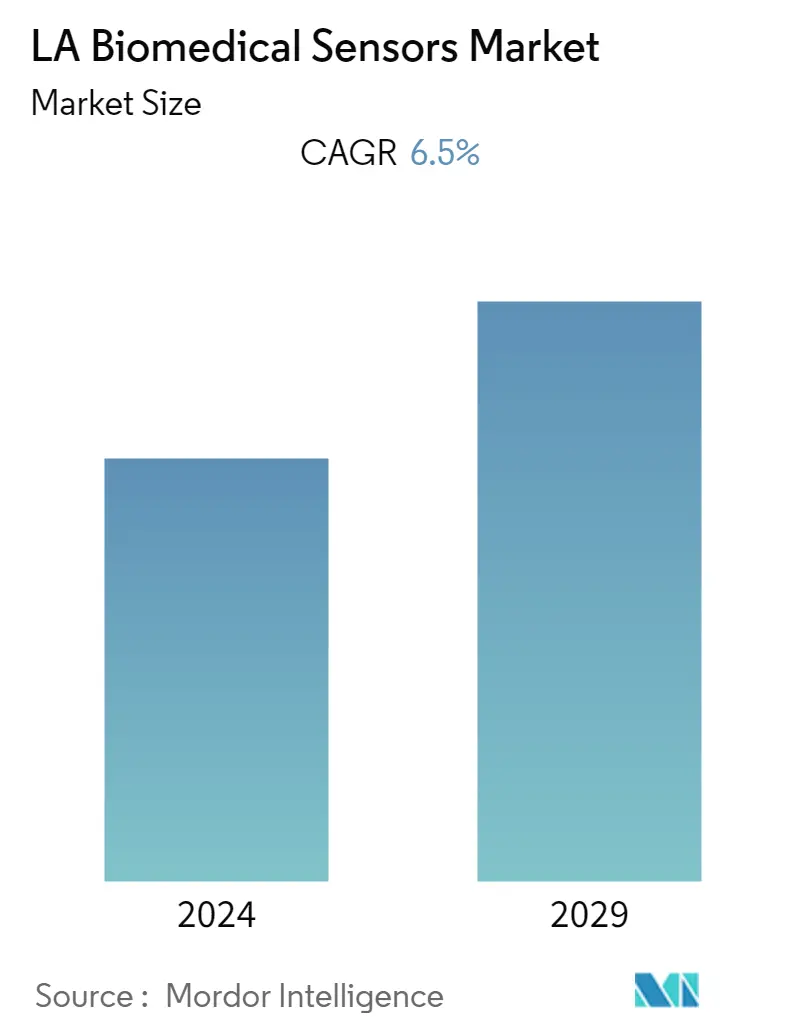Market Size of LA Biomedical Sensors Industry

| Study Period | 2019 - 2029 |
| Base Year For Estimation | 2023 |
| Forecast Data Period | 2024 - 2029 |
| Historical Data Period | 2019 - 2022 |
| CAGR | 6.50 % |
| Market Concentration | Low |
Major Players
*Disclaimer: Major Players sorted in no particular order |
Need a report that reflects how COVID-19 has impacted this market and its growth?
Latin America Biomedical Sensors Market Analysis
The Latin America Biomedical Sensors Market is expected to register a compound annual growth rate of 6.5% over the forecast period.
- Technological advancements in the field of biomedical sensors using microtechnology and nanotechnology will bring tiny, robust, smart, and cost-effective sensors that are adaptable to the individual genetic formulation. These sensors can be set to trigger alerts when they enlist unpredictable readings, screen the existence of toxic agents in the blood, or empower drugs directly into the circulatory system. Investments in developing sensors with such capabilities will act as a major factor for the growth of the market, and eventually, these products will find huge demand in the healthcare industry.
- Biomedical sensors are driven by the increased demand in hazardous environments, utilization in situations resulting from natural disasters, increased demand in the healthcare sector for diabetic and heart patients, and embedded monitoring of the patients. The advancement in technology has made it possible to build a biomedical sensor using nano and micro technology, making it tiny, robust, smart, and cost-effective. The early detection of irregularities in the health status of the patients will contribute to a better quality of life.
- Even though biomedical sensors are playing a major role in life-saving, they are facing certain challenges such as patient's safety and comfort due to strong electromagnetic fields, transferring energy from external to internal parts with high efficiency and high data rates, limited computation and data storage, and ultra-low power consumption.
- Antimicrobial resistance, poor lifestyles, alcohol consumption, and smoking all contribute to the increased prevalence of lifestyle-related disorders, including diabetes. According to the International Diabetes Federation, 463 million persons had diabetes in 2019, with 700 million projected by 2045. As a result, the demand for biomedical sensors for routine health monitoring is growing. Furthermore, cardiovascular diseases (CVD) constitute a serious threat to human health and place a considerable financial burden on both developed and developing countries around the world. This necessitates the use of patient monitoring devices to reduce the number of people who die as a result of lifestyle-related diseases.
- COVID-19 positive cases are becoming more common in South and Central America. The number of infections in Latin American countries is rising as the second wave of COVID-19 spreads. Brazil is currently ramping up its clinical efforts in the fight against the new coronavirus. As a result, COVID-19 detection tests are becoming increasingly popular. According to import statistics maintained by one of Peru's largest diagnostic companies, more than 5 million SD biosensor tests were imported to the country. In the long run, such initiatives would provide considerable growth prospects for the biomedical sensors market in South and Central America.
